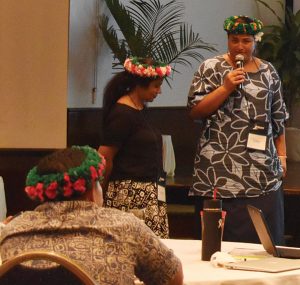Pacific Chronic Disease Council takes aim at lowering NCD rates

Representatives of member nations of the Pacific Chronic Disease Council talk about the challenges they face in dealing with non-communicable diseases in their respective communities on the second day of a five-day learning session at the Fiesta Resort & Spa Saipan’s Hibiscus Hall. (Jon Perez)
Representatives of member-nations of the Pacific Chronic Disease Council are on the island for a five-day learning session at the Fiesta Resort & Spa Saipan’s Hibiscus Hall, with the ultimate goal of sharing information on curbing the rates of NCDs in the Pacific.
The conference began last Sunday with a pre-meeting session.
Commonwealth Healthcare Corp. public information officer Sami Birmingham-Babauta said, “[The PCDC] is a regional coalition that focuses on decreasing the burden of diabetes, hypertension, and other related NCDs for the U.S.-affiliated Pacific Islands.”
Doctors and other health workers from American Samoa, Guam, the Federated States of Micronesia (the states of Chuuk, Kosrae, Pohnpei, and Yap), the Republic of the Marshall Islands (Majuro and Ebeye), and Palau are taking part in the conference, together with CNMI representatives.
Each representative presented statistics and gave updates on how they are battling NCDs, especially diabetes. Pacific islanders are plagued by high diabetes rates that lead to heart diseases, blindness, and amputations.
Patrick S. Luces, Guam’s PCDC chair in the Department of Public Health and Social Services, said programs to prevent NCDs would save patients from the costs of treating complications.
The Marshall Islands, during their presentation, said NCDs remain the leading cause of death and disability in the Marshall Islands. Last year alone, 182 people in Marshall Islands died due to diseases related to diabetes, cardiovascular disease, and cancer.
Cardiovascular-disease deaths in the Marshall Islands increased from 162 in 2014 to 206 last year, while diabetes deaths dropped from 451 to 415 in the same period. Cancer deaths rose from 128 to 137 while the disease itself had a slight bump from 10 to 18.
The number of diabetes patients in Majuro is also on the rise, an increase of 18 percent from October 2016 to March this year. The latest number of patients now total over 2,400, compared to less than 2,100 almost two years ago.
Health officials in Majuro know the importance of reducing the leading causes of death in adults while at the same time preventing the youth from developing NCDs. Having a multi-sector group and collaboration would strengthen a strategic plan in combating NCDs.
RMI health officials had already established an NCD Coalition with four task groups and strengthened their community outreach programs that include home visits for disabled patients.
The learning sessions continued yesterday where they discussed process mapping of the Pacific healthcare systems and charting the course in preventing NCDs, while a panel discussion will also be held before the end of the morning session.



























